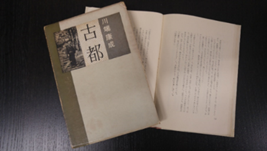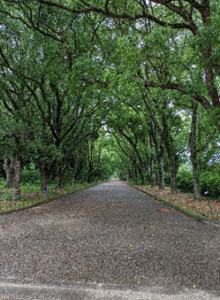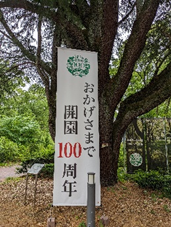Yasunari Kawabata’s birthday month: June <1>
 “Koto” first edition price 350 yen Published June 25, 1962 |
 
Kyoto Botanical Garden Camphor Tree-lined Avenue |
Yoshie Doi
June is the birthday month of Yasunari Kawabata. He was born on June 14, 1899, so this year marks his 125th birthday. It has been 52 years since his death. The Kyoto Prefectural Botanical Gardens, which will celebrate their 100th anniversary in 2024, often feature in “The Ancient Capital.” I visited the gardens twice, in May and June. In Japan, copyright lasts for 70 years, but in some countries, copyright lasts for 50 years. The novel “The Ancient Capital” has become popular since last year, partly because the copyright for the book has expired in China and other countries. It is expected that the number of visitors from overseas who are interested in famous places such as Bodai Falls in the Nakagawa district, which appears in “The Ancient Capital”, will increase.
June is the birth month of Yasunari Kawabata, so I would like to say a few words about him and Kyoto botanical garden.
“The Ancient Capital” began to be serialized in the Asahi Shimbun newspaper in October 1961, shortly after the reopening of the Kyoto Prefectural Botanical Gardens, and the following is what was written in the article:
<The American military had built homes in the botanical gardens, and of course Japanese people were forbidden from entering, but the military left and the gardens were returned to their original state.
Otomo Sosuke of Nishijin had a favorite tree-lined path in the botanical gardens. It was a path lined with camphor trees. The camphor trees were not large, and the path was not long, but he often walked there. Even when the camphor trees were in budding season…
“I wonder what’s become of those camphor trees,” he would sometimes wonder, as he listened to the sound of the loom. Surely they hadn’t been cut down by the occupying forces. Sosuke waited for the botanical gardens to be reopened.>
Trees that have been there since the garden first opened, such as camphor trees over 100 years old and large Himalayan cedars, still remain. Walking along the tree-lined path leaves you feeling refreshed.
Perhaps it’s because we are receiving the blessings of nature. There is a refreshing feeling that can only come from a botanical garden surrounded by trees.
Kyoto Prefectural Botanical Garden
The year 2024 marks the 100th anniversary of the opening of the Kyoto Prefectural Botanical Garden, which opened on January 1, 1924 (Taisho 13). Since its opening, the garden has cultivated 12,000 plants of 12,000 varieties in its vast 240,000 m2 garden. In spring, you can enjoy 180 varieties of cherry blossoms, in summer, rows of camphor trees over 100 years old, and in autumn, about 1,000 colorful autumn leaves. You can enjoy beautiful plants in every season. In addition, the observation greenhouse, one of the largest in Japan, has a wide range of plants from tropical to alpine plants, and many plants that are exhibited or blooming for the first time in Japan, making it one of the largest greenhouses in Japan.
The rose garden, where around 320 varieties bloom in spring and autumn, attracts many visitors in May when it is in season and you can enjoy the view with Mt. Hiei as a backdrop. The philosophy of the garden’s designer is also reflected in the garden, so be sure to take a look at the distant mountain as well.
Kyoto Prefectural Botanical Garden was Japan’s first public botanical garden and opened in 1924, but was taken over by the Allied forces from 1946 to 1947, finally reopening in April 1961. (Continued in next issue)
The end of document
Translated by Masami Otani
